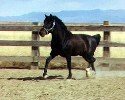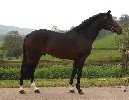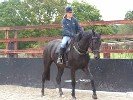breeding brown horses




In cases where a "brown" colour is due to a dilution of black then crossing brown horses together would result in black, brown and chestnut foals, and other dilute types depending on whether the dilution gene(s) is/are dominant or recessive, and whether red pigment is affected as well as black (perhaps to make chestnut into sorrel).
Where brown horse have the brown agouti allele then breeding brown horses together would also result in brown, black or chestnut foals, but not bay ones, as follows below. If Gower is also right about the affect of the alleles on shades, the chestnut foals would be expected to be liver and standard chestnut, rather than the chestnut and sorrel which might be more likely for a dilution model.
If both the parents are heterozygous at the extension locus then there is a 1 in 4 (25%) chance of the foal being chestnut. If one or both of the parents are of genotype E+E+ then only black or brown foals can result. Black foals will only be produced if both parents are of genotype AtAa at the agouti locus.
The following demonstrates what happens when two brown horses are bred together which are both heterozygous at both loci:
Genetic contribution from mare:
Genetic contribution from stallion:
E+At E+Aa eAt eAa
E+At E+E+AtAt
brown E+E+AtAa
brown E+eAtAt
brown E+eAtAa
brown
E+Aa E+E+AtAa
brown E+E+AaAa
black E+eAtAa
brown E+eAaAa
black
eAt E+eAtAt
brown E+eAtAa
brown eeAtAt
chestnut eeAtAa
chestnut
eAa E+eAtAa
brown E+eAaAa
black eeAtAa
chestnut eeAaAa
chestnut
There is a 9:3:4 ratio of brown: black : chestnut, or put another there is just over 56% chance of a brown foal from any particular breeding. (The agouti allele in the chestnut horses is irrelevant to the phenotype since there is no black pigment to distribute, either uniformly or in the points.)






